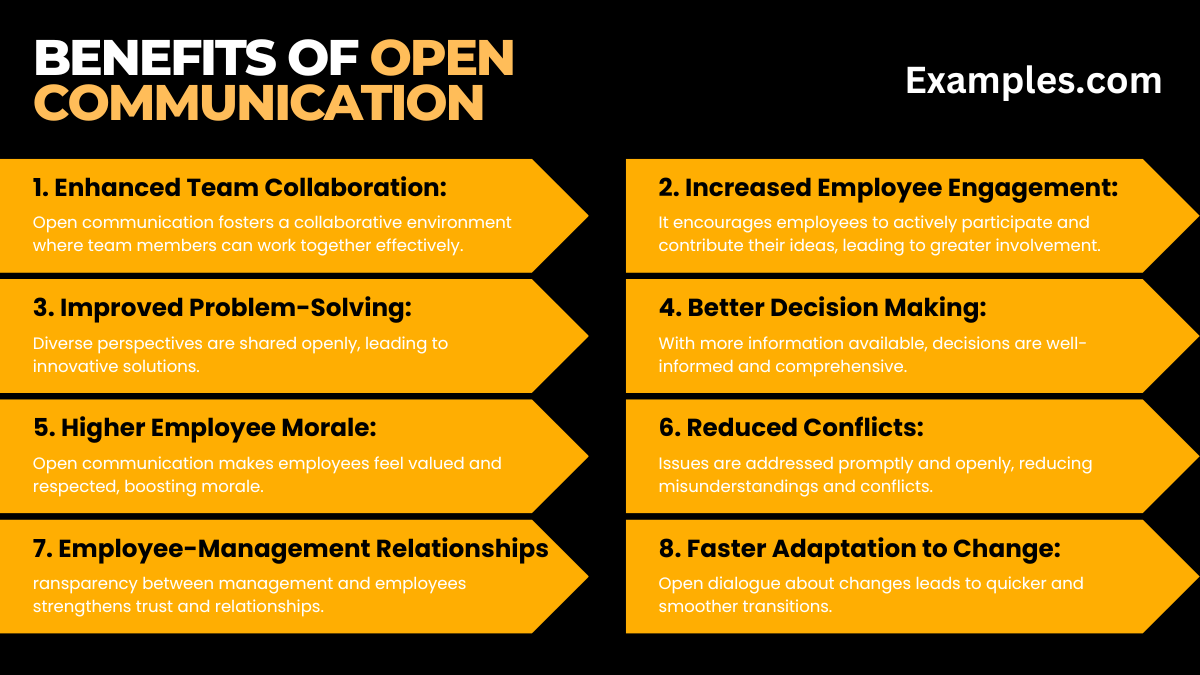7+ Benefits of Open Communication
Open communication is a pivotal element in creating a thriving workplace. This guide delves into the myriad benefits of open communication, using practical communication examples to illustrate its impact. From enhancing team collaboration to improving decision-making, open communication paves the way for a more dynamic and effective work environment. Explore how it fosters trust, boosts morale, and drives innovation, essential for any successful business. This comprehensive guide, enriched with real-world examples, will provide you with insights into harnessing the power of open communication for organizational growth and employee satisfaction.
Download Open Communication Benefits in PDFWhat are the Benefits of Open Communication? – Meaning

Open communication is the straightforward and honest sharing of information and feelings within an organization. It fosters a culture where team members can freely express their thoughts and listen to others without fear of judgment. The benefits include enhanced employee engagement, improved leadership communication, and effective business communication. This approach leads to better team collaboration, higher morale, efficient problem-solving, and more informed decision-making. Open communication essentially creates a more positive, inclusive, and productive work environment, pivotal for organizational success.
10 Benefits of Open Communication

Open communication in the workplace stands as a cornerstone for organizational success and employee satisfaction. It’s not just about conveying messages but building an environment where dialogue fosters growth, innovation, and harmony. This guide will explore 10 key benefits of open communication, illustrating how it revolutionizes workplace dynamics. From enhancing team collaboration to nurturing leadership, each point delves into the transformative impact of open communication, backed by communication styles and business communication strategies.
- Enhanced Team Collaboration: Open communication fosters a culture of teamwork. Employees freely share ideas, leading to creative problem-solving and innovation. This collaboration is vital for business communication and project success.
- Increased Employee Engagement: When employees feel their voices are heard, their commitment to their work and the company increases. This engagement is crucial for organizational growth and employee satisfaction.
- Improved Problem-Solving: Diverse perspectives brought forward through open communication lead to more effective problem-solving. It encourages a communication style that values multiple viewpoints, enhancing the quality of solutions.
- Better Decision Making: Open communication provides a wider array of information, enabling better-informed decisions. It ensures all aspects of a situation are considered, leading to outcomes that benefit the entire organization.
- Higher Employee Morale: Employees in an environment of open communication feel valued and respected, boosting morale. This positive atmosphere is essential for maintaining a motivated workforce.
- Reduced Conflicts: Transparent and honest communication helps in addressing issues before they escalate. It plays a vital role in conflict resolution, creating a harmonious work environment.
- Stronger Employee-Management Relationships: Open communication builds trust between employees and management. This trust is fundamental for leadership communication, fostering strong, respectful, and productive relationships.
- Faster Adaptation to Change: In an open communication setting, employees are more receptive to changes. Transparent discussions about changes facilitate smoother transitions and quicker adaptation.
- Enhanced Leadership Communication: Leaders who practice open communication are seen as more credible and approachable. This enhances their ability to lead effectively and inspires trust among team members.
- Cultivation of a Positive Work Culture: Open communication contributes to a positive and inclusive work culture. It’s essential for long-term success and attracts top talent, as it creates an environment where employees feel supported and empowered.
What are the Benefits of Open and Transparent Communication?
Open and transparent communication is essential in any organization for fostering trust, enhancing collaboration, and improving overall productivity. It allows for a free flow of ideas and feedback, which leads to innovative solutions and better decision-making. Open dialogue encourages employees to express their concerns and opinions, leading to a more inclusive work environment. This transparency in communication reduces misunderstandings and conflicts, ensuring a smoother operation. Moreover, it strengthens employee-manager relationships, creating a more cohesive and supportive work culture. Overall, open and transparent communication is a key driver for organizational success and employee satisfaction.
Benefits Of Open Communication In A Company
The benefits of open communication in a company are vast and impact various aspects of the business. It leads to improved employee engagement, as staff feel more valued and involved in the company’s operations. Open communication enhances problem-solving and decision-making processes, with diverse ideas leading to innovative strategies. It also plays a significant role in conflict resolution, maintaining a harmonious work environment. Furthermore, it supports effective leadership communication, with leaders who are transparent and communicative often being more respected and trusted by their teams. In essence, open communication is pivotal in building a positive, productive, and adaptable company culture, crucial for long-term business success.
What are the Benefits of an Open Communication System?
An open communication system enhances transparency, fosters trust, encourages collaboration, and leads to more informed decision-making and problem-solving within an organization.
Why is it Important to Keep the Lines of Communication Open?
Keeping the lines of communication open is essential for ensuring transparency, building trust, facilitating quick problem resolution, and maintaining a healthy, collaborative work environment.
What are the Benefits of Open Communication in Families?
Open communication in families strengthens relationships, enhances mutual understanding, builds trust, and supports emotional well-being by fostering a supportive and inclusive family environment.
Open communication in the workplace offers significant benefits, as highlighted by various statistics. Notably, effective communication can improve productivity by up to 25%, underscoring the direct impact of clear and open communication channels on employee performance and organizational success??. Moreover, companies with effective communication strategies tend to have more engaged employees. For instance, 85% of employees feel more motivated when management shares company news updates, highlighting the importance of transparency and regular communication in boosting employee morale and productivity??.
The adoption of digital communication tools has become increasingly prevalent, especially in remote and hybrid work environments. About 37% of remote workers, 23% of on-site workers, and 24% of hybrid workers use VoIP systems, indicating a shift towards more versatile and accessible communication methods??. Additionally, the majority of workers (56%) rely on video for communication, with 55% preferring audio, reflecting the diverse preferences and needs of today’s workforce in terms of communication tools and platforms??.
The benefits of open communication are far-reaching and integral to both professional and personal realms. In organizations, it fosters trust, encourages collaboration, and drives effective decision-making. In personal settings like families, it strengthens bonds and supports emotional well-being. Embracing open communication is key to building strong, transparent, and supportive relationships, essential for success and harmony in all aspects of life.



